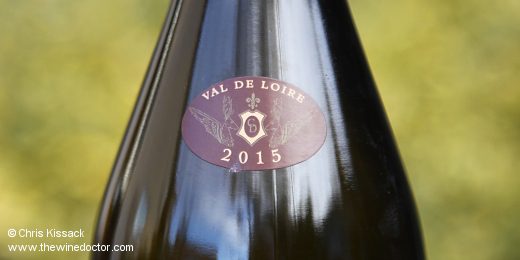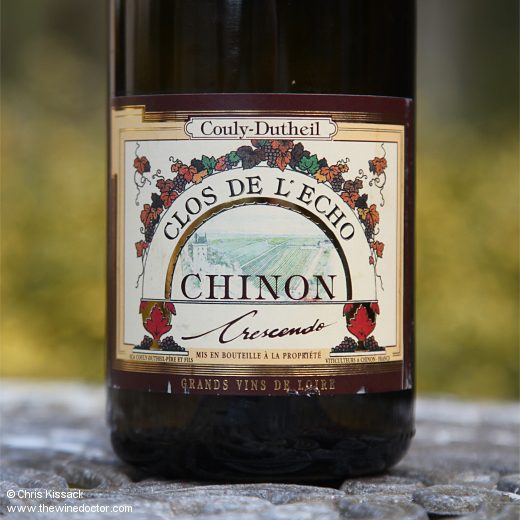Couly-Dutheil Chinon Clos de l’Echo Crescendo 2015
With an avalanche of Bordeaux 2020 reports coming this week, I thought I should look somewhere else for my Weekend Wine. That brings us to the Loire Valley (surprise!), and the 2015 Clos de l’Echo Crescendo from Couly-Dutheil.
The Clos de l’Echo has attained a somewhat mythical status within the Chinon appellation, and this status reflects in part the locally-held belief that this vineyard once belonged to Antoine Rabelais, a 16th-century advocate who lived in Seuilly, on the south bank of the Vienne, just downstream of Chinon. If you hadn’t already guessed, Antoine is best known as the father of doctor, poet and novelist François Rabelais (c.1494 – c.1553).
Mythology provides no immunity against disease, however, as was evident by the devastation wreaked upon the Clos de l’Echo phylloxera. By the early years of the 20th century some parts of the clos were devoid of vines, having been replaced by arable crops. This was the situation when Baptiste Dutheil (born 1880), who founded Couly-Dutheil (he married his cousin, Marie Couly, hence the name), purchased a slice of the clos in 1925; after the acquisition he set about planting the site, and continued to do so throughout the 1930s. It was not until 1951 that the broader expanse of the clos came into his family’s hands, when another distant cousin, René Couly (born 1910), who had joined the family business, purchased several more plots. From this point on Couly-Dutheil owned the entire clos; this remains the case today.

The wines were initially sold under the name of Chinon Moulin-à-Vent, named for the windmill that stood among the vines. This changed when the growers of Beaujolais complained (unsurprisingly so, I guess), and the wine was renamed Clos de l’Echo, after the echoes that can be bounced off the rear walls of Chinon’s royal fortress, which sits directly south of the clos.
I often imagine that visitors to the town who discover the south-facing slope of vines opposite the fortress, secluded behind stone walls, conclude they are surveying the entirety of the clos. In truth this is one small part of it; the clos covers an impressive 17 hectares, running up the aforementioned slope and onto the plateau above, before falling away again down a gentle north-facing incline. While the soils are a remarkably homogenous mix of clay and limestone, the aspect thus varies considerably; reflecting this, the harvest is split up to three ways.
The largest part is earmarked for the Clos de l’Echo cuvée, vinified in stainless steel only, with no use of oak at all, neither during fermentation or élevage; it did used to see some oak, but you have to look back to vintages prior to 2003 for that. Then there is the Clos de l’Echo Crescendo, a smaller-production cuvée made only in better vintages, and sourced from 2.5 hectares of vines on the south-facing slopes opposite the château. Picked at lower yields, this cuvée is matured in a mix of one-third new barrels and one-third used barrels, while one-third remains in tank. This is enough to add a heavy imprint of oak to the wine, and – just like all the 2020 Bordeaux I tasted last month – it needs time in bottle, certainly more than the ‘standard’ Clos de l’Echo requires, anyway. Finally, fruit not considered up to scratch for these two cuvées is channelled into another Couly-Dutheil wine, such as Baronnie Madeleine. This is particularly true of fruit from the more north-facing slopes.

Arnaud Couly tends to pick the Clos de l’Echo late – it is always one of the last vineyards to be harvested in the appellation – giving an advantageous degree of ripeness which historically has been in its favour (I am not sure this is true in every modern vintage though, in particular the 2018). He also tends to release late; as a consequence I purchased this vintage long after I published my Loire 2015 at Three Years report, and I have been sitting on the bottles ever since, waiting for the right moment to pull the cork on the first.
Which is now.
The 2015 Clos de l’Echo Crescendo from Couly-Dutheil presents a characteristically dark and glossy hue in the glass, wrapped within a thin yet vibrant raspberry rim. It seems quite quiet on the nose at first, but it simply needs time to open up; with time the aromas of blackcurrant, sooty blackberry and currant makes themselves known, followed up by some attractive herby notes suggestive of bay and green peppercorn. There is also a little sweet oak showing here, immediately after pulling the cork, although it does not dominate, and it soon fades into the background. There follows a very convincing palate, firm and dark, bursting with vibrant blackcurrant fruits complicated by twists of orange peel and lavender, all set over a sinewy texture and a ripe grip of dry tannins. It has density but also a sense of tension, but most of all it comes packed with dry grip, leading up to a wonderfully succulent, tannin-infused finish. This is an impressive example of the Crescendo cuvée, showing fine potential, in keeping with what was – at the time – the strongest vintage in the region for reds since 2010. At just over seven years of age I would say this needs another five-to-eight years in bottle before it will show a more approachable integration. I will hang on to my other bottles until then. The alcohol is a very reasonable 13.5%. 95/100 (23/1/23)
Read more in:
- My detailed profile of Couly Dutheil
- My report on the Loire 2015 vintage
- My guide to Cabernet Franc
Find Couly-Dutheil Chinon Clos de l’Echo Crescendo 2015 on Wine Searcher: ![]()
